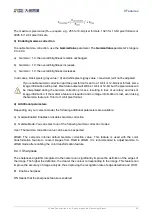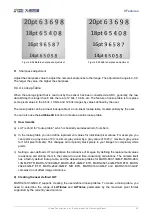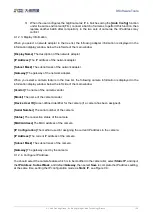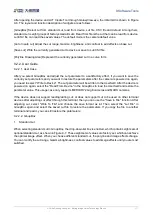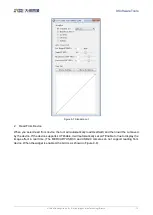
8.Features
© China Daheng Group, Inc. Beijing Image Vision Technology Branch 98
8.5.3. Stream Channel Packet Delay
The stream channel packet delay (SCPD) is used to control the bandwidth of the image streaming data of
the camera. The packet delay is the number of the idle clocks that inserted between adjacent network
packets transmitted in the stream channel. Increase the packet delay can reduce the camera's bandwidth
usage, and it may also reduce the camera's frame rate (the camera frame rate also depends on the
exposure time, camera acquisition time).
The camera's packet size, packet delay and reserved bandwidth determine the effective network
bandwidth. The effective network bandwidth is calculated as follows:
The time required to transmit a single stream packet:
T
𝑑𝑎𝑡𝑎
= (𝑆𝑖𝑧𝑒
𝑝𝑘𝑡
× 8𝑏𝑖𝑡𝑠) 𝑆𝑝𝑒𝑒𝑑
𝑙𝑖𝑛𝑘
⁄
The time of packet delay is:
𝑇
𝑑𝑒𝑙𝑎𝑦
= 𝐷𝑒𝑙𝑎𝑦
𝑝𝑘𝑡
125,000,000
⁄
Among them: the
𝑆𝑖𝑧𝑒
𝑝𝑘𝑡
is packet size,
𝐷𝑒𝑙𝑎𝑦
𝑝𝑘𝑡
is packet delay,
BandW
𝑟𝑒𝑠𝑒𝑟𝑣𝑒
is reserved bandwidth,
𝑆𝑝𝑒𝑒𝑑
𝑙𝑖𝑛𝑘
is link speed.
Effective network bandwidth:
Band𝑊
𝑎𝑣𝑖𝑎𝑙
= (𝑆𝑖𝑧𝑒
𝑝𝑘𝑡
× 8𝑏𝑖𝑡𝑠 × (1 − Band𝑊
𝑟𝑒𝑠𝑒𝑟𝑣𝑒
)/(𝑇
𝑑𝑎𝑡𝑎
+ 𝑇
𝑑𝑒𝑙𝑎𝑦
)
Example 1
: The packet size is 1500, the packet delay is 1000, the reserved bandwidth is 20%, and the
link speed is 1Gbps.
The time to transport a single stream packet is:
𝑇
𝑑𝑎𝑡𝑎
= (1500 × 8) 1000,000,000
⁄
= 12𝜇𝑠
The time of packet delay is:
𝑇
𝑑𝑒𝑙𝑎𝑦
= 1000 125,000,000
⁄
= 8𝜇𝑠
The effective network bandwidth is:
Band𝑊
𝑎𝑣𝑖𝑎𝑙
= (1464 × 8 × (1 − 0.2))/(12𝜇𝑠 + 8𝜇𝑠) = 468𝑀𝑏𝑝𝑠
Note: Each stream packet contains 36 bytes of network header data, and a packet with the size of 1500
bytes contains only 1464 bytes of valid data.
Example 2
: The packet size is 8192, the packet delay is 2000, the reserved bandwidth is 20%, and the
link speed is 1Gbps.
The time to transport a single stream packet is:
𝑇
𝑑𝑎𝑡𝑎
= (8192 × 8) 1000,000,000
⁄
= 66𝜇𝑠






